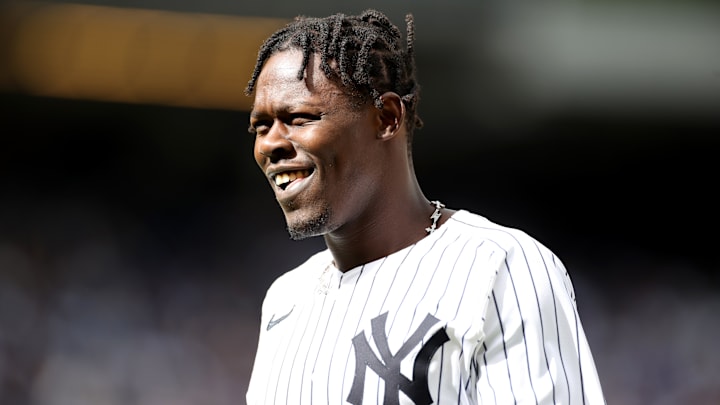Jazz Chisholm Jr. will begin his rehab assignment with the Double-A Somerset Patriots this week at third base, a position he’s played exactly 45 times at the major-league level (all of those games were with the Yankees in 2024). Of course, this implies that Chisholm may also play third when he’s back with the Yankees after his rehab stint.
“Maybe, we’ll see,” manager Aaron Boone told the New York Post on May 28 about the possibility of Jazz at the hot corner. “I want him to work over there this week and in his games over there, keep that flexibility. Then we’ll make a decision one way or the other.”
On the one hand, the move is understandable in that the Yankees have been experimenting a bit at third this season. Oswaldo Cabrera, Oswald Peraza, Jorbit Vivas, and Pablo Reyes have all spent time there during the club’s first 55 games. Cabrera is now injured and the other three haven’t quite found their swing thus far (Peraza has been the best of the bunch, albeit with a meager OPS of .569). Conceptually, finding a more reliable option at third would be a blessing.
The Yankees are prioritizing DJ LeMahieu's nonexistent bat, to the detriment of the team
The problem, of course, is that Jazz would be sent to third to make room for DJ LeMahieu at second. Although Yankees fans shouldn’t forget the glorious feeling of past years when LeMahieu would step up to bat with players in scoring position, those times are decidedly over. Thus far since returning to the Bronx, DJ hasn’t been any better than his miserable performance in 2024. As of May 29, his OPS+ stood at 45 and his WAR at 0.2. His batting average, typically a stat in which he excels, is below .200. It’s a small sample size of only 41 plate appearances, but it’s a discouraging one. It’s also worse than what we’ve seen from Peraza.
Why then, one might wonder, would Jazz be sent to third base, a position where his .940 fielding percentage is notably worse than his numbers at second, which clock in at .973 this season and at .982 in 2022, his All-Star year. Why get a worse defensive performance out off Jazz just to accommodate a player who hasn’t been above average at the plate since 2022?
It’s a bit of a head scratcher that only makes sense if the Yankees are all-in on giving DJ his last chance to be a regular presence in the starting lineup. Perhaps LeMahieu deserves such an opportunity, but it’s hard to make a rational argument for it.
An easier case to make would be this: give Peraza an honest-to-God shot at being the Yankees’ starting third baseman. He’s been heralded at times for his defense, and he’s shown the occasional burst of talent offensively. Admittedly, as each day passes, it looks like he won’t be a long-term solution at third. But until the trade deadline looms, it makes more sense to give the one-time top prospect a shot, rather than indulge a veteran who can’t hit. Peraza has a limited sample size at the big league level. It's possible that he might not be good, but we know LeMahieu has largely been a liability in some capacity since 2021. Why completely shun another top prospect who once had a bright future for a soon-to-be 37-year-old whose playing days are likely over?
As for Jazz, the roadmap is simple: keep him at second base, where he truly excels.
